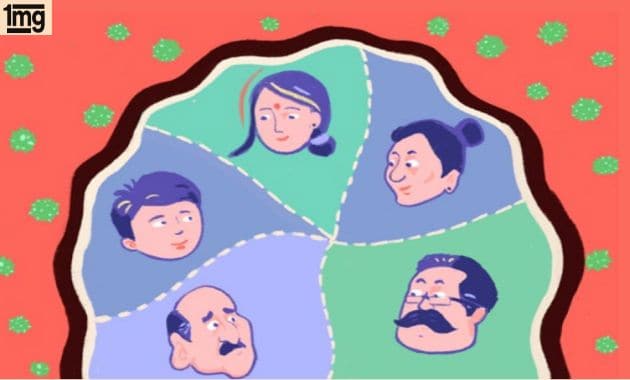
Wondering what exactly is social distancing? Here is our one-stop guide for what you must know about social distancing, based on the updated guidelines by the WHO, CDC and MoHFW with inputs from various medical experts. Some words you might have heard already
-Social distancing,
-Lock down,
-Home quarantine,
-Self-isolation
Is there any difference between quarantine, isolation and social distancing?
YES. Although used interchangeably, they don’t mean the same thing.
Isolation: Separates sick people with an infected disease from people who are not sick[1]
Quarantine: Separates and restricts the movement of people who were exposed to an infected disease to see if they become sick[1]
Social distancing: Reduces the contact of people who are not sick among themselves as a precautionary measure.
Social distancing simply means reducing contact and maintaining a physical distance between yourself and others. As of now, 1 metre is considered safe. That’s about an arm’s length. Notably, the infected droplets can travel up to around 1 metre in the air and quickly settle on the surfaces.
Why is there a need for social distancing?
Social distancing is important because the novel coronavirus is most likely to spread from
person-to-person. It will help in:
– Reducing the chances for coronavirus transmission
– Lowering the pace and extent of the spread of coronavirus
How long do I need to follow social distancing?
Till March 31, 2020 as per NCDC’s current guidelines in place, the situation is evolving rapidly and it will largely depend on how we perform as a community to slow down the spread of Coronavirus[2].
Fundamentals First
The 4 important stages of a pandemic spread are
Stage I: Imported cases only (from affected countries)
Stage II: Local transmission (close contact of an infected person, like family and friends)
Stage III: Community spread (some of the infected people in an area might not know how or where they got infected)
Stage IV: Spread through several communities (epidemic), with no clear endpoint
India is still at stage II, as per WHO’s situation report on March 28, 2020[3] This means there is no evidence of community spread as of now.
Here’s a No Panic Helpguide For Coronavirus (COVID-19)
Is there any WHO-approved standard protocol to check community spread?*
Yes. The designated labs perform testing of coronavirus on randomly chosen samples from different communities across the country. Consistent negative results on such testing indicates, “the spread is only through local transmission mode, and has not reached to the masses”.
How does social distancing work?
It breaks the chain. The more space between you and others, the harder it is for the virus to spread.
Will it really be effective?
Yes, highly likely. Learning from previous pandemics have proven that early and rapid implementation of social distancing can significantly reduce the spread of the infection and lower death rates. It helps in “flattening the curve”.
Understanding “Flattening the curve”
It means to keep the daily number of disease cases on the lower side. Social distancing may or may not be able to reduce the spread of coronavirus, but it ensures that the number of infected people at any one time is limited.
A high curve indicates a quick spread of coronavirus, limited medical care and healthcare support, and a likely increase in the number of deaths. A low curve means slow spread of coronavirus, which gives doctors the time and facilities to treat more people (and save more lives).
Why should I care if I don’t think I can get sick?
Your individual risk may be low. But taking steps like these will benefit the society as a whole. An individual who doesn’t get very sick might still pass the infection along to others, including parents, neighbors, people on the bus, etc. A single person’s behavior can affect people faraway.
**Consult India’s best doctors here**
Can I go out of my house?
Stepping out of the house is not an absolute no. The primary objective is to reduce physical contact by staying indoors. But those who are symptom-free and not part of an at-risk group, can still go out. Ensure to follow proper hand hygiene before leaving and on returning.
What are the action points?
In a nutshell, during social distancing
AVOID
-Gyms, museums, swimming pools & theatres,
-Educational institutes (schools, universities, colleges, etc.),
-Cultural and social events, sports events or weddings,
-Sleepovers or meeting visitors for frivolous/ nonessential cause
-In-person meetings with unknown people
FOLLOW CAUTION
-At local restaurant (especially indoors),
-Grocery shopping at a crowded market,
-Office places, post-offices, hospitals and lab facilities.
-Shopping malls at peak hours or markets (in general, like anaj mandi, sabji mandi, etc.),
-Bus depots, railway stations & airports,
GOOD-TO-DO
-Eat healthy & Sleep well,
-Practice stretching, yoga, and meditation at home,
-Don’t panic, just be watchful,
-1-to-1 check-in with friends, while avoiding close contact
-Group video chats with friends
-Staying connected through social media & calls
-Read a book or enroll in online learning programs
All of us need to adapt to a new way of living, working, and forging relationships. Step back, stay at home, and help slow down the spread of coronavirus.
(The article is reviewed by Dr. Varun Gupta, MD Pharmacology and Dr. Ashish Ranjan, MD Pharmacology)
Recommended Reads:
Can Cash Handling Put YOU At Risk Of Coronavirus (COVID-19)?
Coronavirus: How To Receive Packages Safely?
References:
1. How to Protect Yourself. Coronavirus Disease 2019 (COVID-19). The Centers for Disease Control and Prevwnrion (CDC). https://www.cdc.gov/coronavirus/2019-ncov/prevent-getting-sick/prevention.html
2. Advisory on Social Distancing Measure in view of spread of COVID-19 disease. NCDC. https://ncdc.gov.in/WriteReadData/l892s/86055753891584369415.pdf
3. Novel Coronavirus (COVID-19). Situation Report – 68. Highlights. The World Health Organization (WHO). https://www.who.int/docs/default-source/coronaviruse/situation-reports/20200328-sitrep-68-covid-19.pdf?sfvrsn=384bc74c_2
4. Schools, Workplaces & Community Locations. Coronavirus Disease 2019 (COVID-19). The Centers for Disease Control and Prevwnrion (CDC). https://www.cdc.gov/coronavirus/2019-ncov/community/index.html